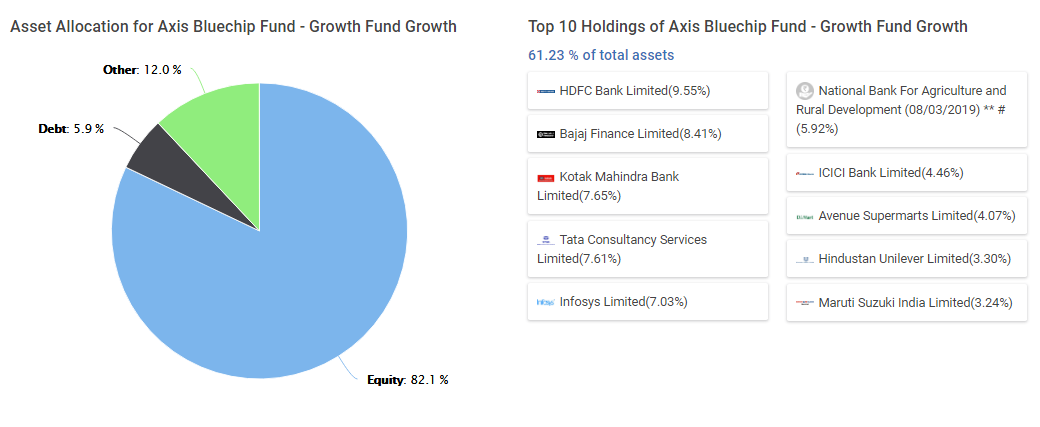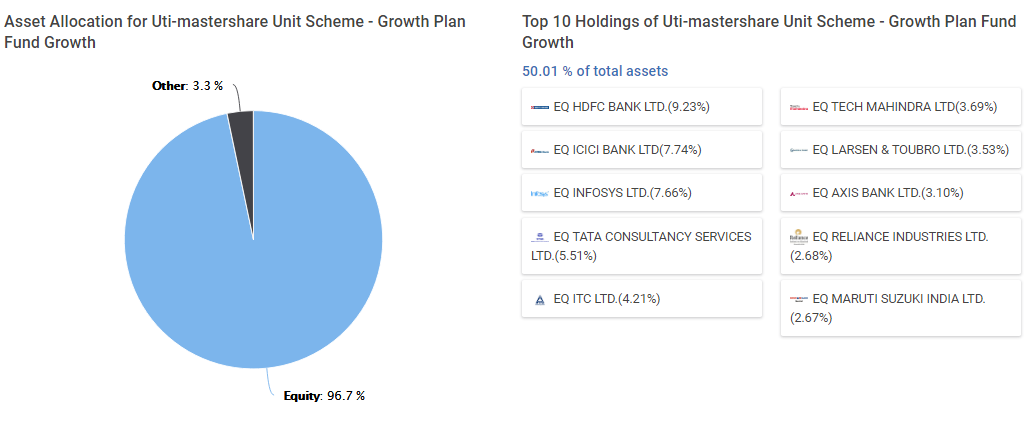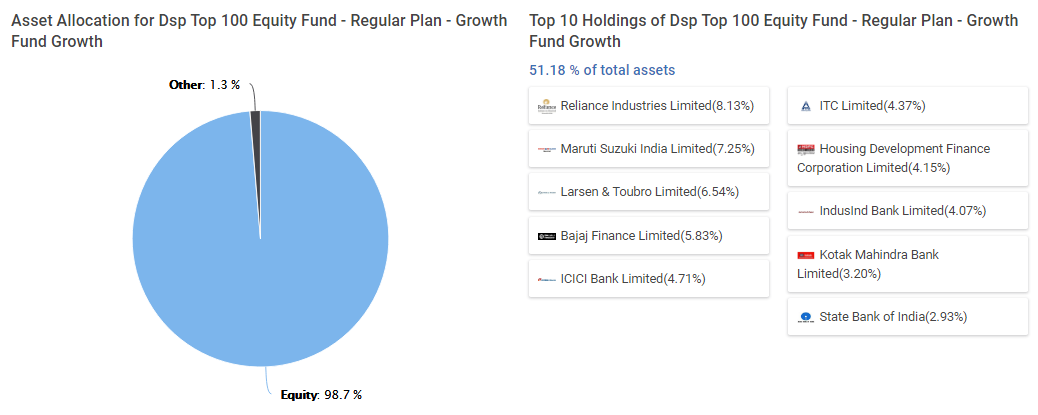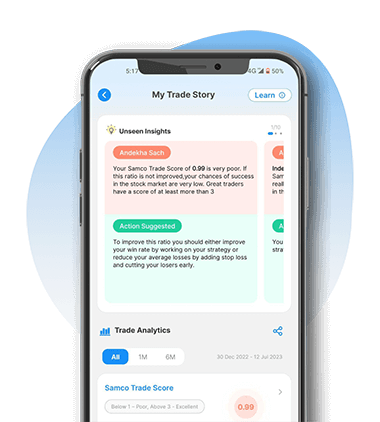
You must be thinking about investing in a mutual fund and might be browsing through the various mutual fund categories. If you have come across the term ‘cap’ and don’t know what it means, read through this article as we through RankMF knowledge center aim to educate you’ll about the basics of mutual funds and all the information and details about mutual funds you will need. Through this article you will know about what is a cap, market-cap based categorization, characteristics of capitalization-based mutual funds and one of the cap based mutual fund - large cap funds, their potential returns based on historical data and risks involved.
- What are Large Cap Funds
- Large cap Funds: Returns and Risks
- Who should invest in Large-cap Funds
- How to Invest in Large Cap Funds
- Top Performing Large Cap Funds on RankMF
1. What are Large Cap Funds?
A. Understanding Market Cap
Market cap refers to the total valuation of the company. It is used to classify the stock into large cap, mid cap or small cap. Market Cap is calculated as-
For instance if you want to calculate the market cap of Coal India Ltd., you take its market price lets say, Rs. 240 and multiply it with total no. of shares which is 620 cr. shares. The market cap of Coal India Ltd. is 620 cr. shares x Rs. 240 = Rs. 148800 cr.
As per Sebi norms, the top 100 companies in terms of market cap are considered as large cap stocks, the next 150 companies i.e. 101st-250th in terms of market cap are considered as mid cap whereas the remaining i.e. from 251st onwards are categorized as small cap stocks. Based on these categorization norms, we can determine that Coal India Ltd. falls under the top 100 companies’ bracket and thereby is a large cap company.
B. Large cap vs. Mid cap vs. Small cap
- Large Cap
A large cap fund predominantly invests in equity of Large Cap Stocks listed on the exchange. As per Sebi guidelines on categorization, a large cap fund must invest a minimum of 80% of your funds in large cap companies. This means that 80% of your investment amount goes in the top 100 companies ranked in terms of market capitalization. The rest 20% can be invested in mid or small cap stocks. As these companies are well reputed, market leaders in their segments, they are considered relatively stable and provide steady growth and lower fluctuations.
- Mid Cap
A Mid Cap Fund invests a minimum of 65% of its total assets in equity & equity related instruments of mid-cap companies as per SEBI norms. Mid cap stocks tend to be riskier than large-cap stocks but less risky than small cap stocks. Mid cap stocks, however, tend to offer more growth potential than large cap stocks and are less volatile then small cap stocks.
- Small Cap
Small cap funds invest a minimum 65% of its funds in small cap companies which tend to have high growth potential as they are usually young, with an outlook for aggressive expansion. On the downside, they are more volatile than their mid and large-cap counterparts as these funds can generate sharply negative returns in times of market instability whereas less-established companies can go out of business.
Furthermore, large cap invests in a very narrow pool of stocks i.e. 100 stocks in comparison to mid and small cap which has a relatively wider universe of stocks to invest in. However, these mid cap and small cap stocks are less liquid than large cap stocks.
| Parameters | Large Cap | Mid Cap | Small Cap |
| Risk | Low | High | Very High |
| Returns | Low | High | Very High |
| Liquidity | High | Low | Very Low |
2. Large cap Funds: Returns and Risks
A. Looking at Potential Returns:
Now that you understand the key difference between mutual fund market caps, we examine the returns generated by some of the schemes and the performance variations for the schemes for a given period. Table 2.1 below provides trailing returns under various fund schemes over different time frames for you to analyze and understand how returns vary over a given period with the same fund category. The 3 year and 5 year lookback period which is a relatively long time frame captures the market cyclicality and averages the returns over time to give a clearer picture. From the data below, it is evident that large cap funds give better returns over the long term.
Table 2.1| Scheme | 1-Year (%) | 3-Year (%) | 5-Year (%) | Since Inception |
| Axis Bluechip Fund - Growth | 6.54% | 12.32% | 14.53% | 11.69% |
| Uti-mastershare Unit Scheme - Growth Plan | -0.39% | 10.16% | 13.77% | 12.82% |
| Invesco India Largecap Fund - Growth | -0.44% | 9.50% | 13.88% | 11.21% |
| Dsp Top 100 Equity Fund - Regular Plan - Growth | -2.72% | 8.87% | 11.62% | 20.73% |
| Kotak Bluechip Fund-growth | -2.11% | 9.18% | 13.98% | 20.10% |
| Franklin India Bluechip Fund – Growth | -3.58% | 9.03% | 12.65% | 20.47% |
| Aditya Birla Sun Life Frontline Equity Fund – Growth | -2.91% | 10.84% | 14.78% | 20.69% |
| Idbi India Top 100 Equity Fund Regular Plan - Growth | -5.92% | 6.94% | 12.16% | 13.31% |
Table 2.2 gives you the annual returns for each scheme to further gauge the performance of the schemes during market cyclicality over the years. Although there is no guarantee that you will get the same returns, it can give you a better understanding of what is right for your portfolio. At the same time, the selection of the fund scheme is equally important as you can see the variation in returns amongst the fund category. Like for instance Axis Bluechip Fund gave a return of 6.5% while the average return for the other schemes in the same category was -2.58%.
Table 2.2| Scheme | 2018 | 2017 | 2016 | 2015 | 2014 | 2013 |
| Axis Bluechip Fund - Growth | 6.54% | 39.09% | -2.70% | -1.24% | 40.85% | 13.49% |
| Uti-mastershare Unit Scheme - Growth Plan | -0.39% | 30.65% | 4.01% | -0.49% | 43.29% | 5.90% |
| Invesco India Largecap Fund - Growth | -0.44% | 29.38% | 3.52% | 4.57% | 39.52% | 9.20% |
| Dsp Top 100 Equity Fund - Regular Plan - Growth | -2.72% | 27.68% | 4.89% | -2.33% | 37.49% | 2.23% |
| Kotak Bluechip Fund-growth | -2.11% | 30.67% | 3.22% | 3.77% | 42.46% | 4.26% |
| Franklin India Bluechip Fund – Growth | -3.58% | 27.35% | 6.53% | 2.02% | 37.22% | 4.08% |
| Aditya Birla Sun Life Frontline Equity Fund – Growth | -2.91% | 31.75% | 7.98% | 1.10% | 44.72% | 9.25% |
| Idbi India Top 100 Equity Fund Regular Plan - Growth | -5.92% | 29.19% | 2.20% | 3.20% | 40.62% | 7.23% |
| Category | 2017 | 2016 | 2015 | 2014 | 2013 |
| Large Cap | 27% | 4.91% | 1.78% | 38.43% | 2.69% |
| Mid Cap | 35.39% | 6.05% | 6.46% | 64.18% | 1.87% |
| Small Cap | 41.14% | 5.48% | 9.41% | 54.94% | 1.93% |
From Table 2.3 we observe that mid cap and small cap funds outperform large cap funds by a wide margin, especially during bull runs. It must be noted that large cap schemes are relatively less volatile and thereby they also offer modest returns as they invest in large cap companies which provide slow but steady returns.
B. Understanding the Risks Involved:
Even though large cap funds invest in well-established, stable and reputed companies they are not entirely risk-free but are relatively less risky than mid and small cap funds. These bluechip companies are subject to market risk and company-specific risk. Company-specific risk is eliminated by diversification benefits provided by mutual funds but the market risk also referred to as systematic risk is the undiversifiable and affects the overall market. These large cap companies are leaders in their domain and generally have a good track record backed by strong management teams and ethical corporate governance in place. Despite the market volatility in the short run, they tend to bounce back as the market recovers. Thereby the large cap funds are considered least risky in the equity category and are ideal for investment for a novice investor as they are comparatively less volatile and risky than mid and small cap.
3. Who should invest in Large Cap Funds?
Below we have listed Benefits of investing in a Large Cap Funds:| Risk-averse investor | You can earn returns over the medium to long-term without being exposed to severe market fluctuations. |
| If you want stability in the portfolio | You can minimize the overall risk of the portfolio by allocating a certain portion of your investments to large-cap funds. |
| New investors | If you are a novice to the stock markets, you won't be able to stomach the volatility in mid and small cap funds right at the start. Large cap funds are considered to be the least risky amongst the equity fund category on the risk-return spectrum and advisable for investment. |
| If you want to build a Retirement plan | The underlying large cap stocks provide slow but steady growth through capital appreciation in stocks which would help you in building a corpus to provide for your future retirement needs. |
| If you have a long-term investment horizon | These funds can generate steady returns and income over time if you are looking to buy and hold and want less risk in your investments. |
4. How to Invest in Large Cap Funds?
Easy online investment through RankMF: Follow these simple steps to start your investment journey: Step 1: Login on RankMF and click on Open an Account. Step 2: Complete your KYC Procedure for A/c opening. Or if already a client, go to Step 3 Step 3: After logging in, use filters to select ‘Equity – Large Cap Fund’ from various categories of mutual funds Step 4: Choose a Large Cap Fund based on our rankings and ratings Step 5: Decide Investment Amount and Investment Route – Lump sum or SIP payment Step 6: Make Payment through Bank A/c or Samco Demat A/c Step 7: Track and watch your Investments grow!5. Top Performing Large Cap Funds on RankMF
1. Axis Bluechip Fund - Growth
| RankMF Rank | 6 |
| Inception Date | 04/01/2010 |
| NAV | Rs 26.87 |
| AUM | Rs 3961.03 Cr |
| Expense Ratio | 2.26% |
| Exit Load | Nil for 10% of investments and 1% for remaining investments on or before 12 months; Nil after 12 months |
| Minimum Investment | Rs. 5000 |
| Minimum SIP Amount | Rs. 1000 |
| Returns: |
| 1 Year (%) | 8.04% |
| 3 Year (%) | 16.06% |
| 5 Year (%) | 14.88% |

2. Uti-mastershare Unit Scheme - Growth Plan
| RankMF Rank | 19 |
| Inception Date | 01/08/2005 |
| NAV | Rs 115.74 |
| AUM | Rs 5576.82 Cr |
| Expense Ratio | 2.33% |
| Exit Load | 1 % before 1 year; Nil on after 1 year |
| Minimum Investment | Rs. 100 |
| Minimum SIP Amount | Rs. 100 |
| Returns: | |
| 1 Year (%) | 1.02% |
| 3 Year (%) | 13.43% |
| 5 Year (%) | 13.82% |

3. Invesco India Largecap Fund - Growth
| RankMF Rank | 28 |
| Inception Date | 17/08/2009 |
| NAV | Rs 27.22 |
| AUM | 173.95 Cr |
| Expense Ratio | 2.66% |
| Exit Load | 1% on or before 1 year; Nil after 1 year |
| Minimum Investment | Rs. 5000 |
| Minimum SIP Amount | Rs. 500 |
| Returns: | |
| 1 Year (%) | 0.89% |
| 3 Year (%) | 13.19% |
| 5 Year (%) | 14.19% |

4. Dsp Top 100 Equity Fund - Regular Plan - Growth
| RankMF Rank | 60 |
| Inception Date | 10/03/2003 |
| NAV | Rs 190.996 |
| AUM | Rs 2641.69 Cr |
| Expense Ratio | 2.27% |
| Exit Load | 1% before 12 months; Nil on or after 12 months |
| Minimum Investment | Rs. 500 |
| Minimum SIP Amount | Rs. 500 |
| Returns: | |
| 1 Year (%) | -3.06% |
| 3 Year (%) | 12.10% |
| 5 Year (%) | 11.27% |

5. Kotak Bluechip Fund - Growth
| RankMF Rank | 69 |
| Inception Date | 02/03/2003 |
| NAV | Rs 219.906 |
| AUM | 1329.95 Cr |
| Expense Ratio | 2.22% |
| Exit Load | 1% on or before 1 year; Nil after 1 year |
| Minimum Investment | Rs. 1000 |
| Minimum SIP Amount | Rs. 100 |
| Returns: | |
| 1 Year (%) | -0.13% |
| 3 Year (%) | 12.63% |
| 5 Year (%) | 13.74% |

Note:
1) All the above funds are open-ended funds.
2) Only those funds which had a buy recommendation on RankMF based on our ranking parameters for evaluating mutual funds are included.
With this, we conclude our discussion on the topic of Large Cap Funds. For more information about investing in mutual funds, stock trading and useful related articles, visit RankMF.com or our investor education center.
(Disclaimer: This content is for information purpose only. Avoid trading and investing based on the information given above. Before investing in stocks or mutual funds, please conduct proper due diligence).







Leave A Comment?